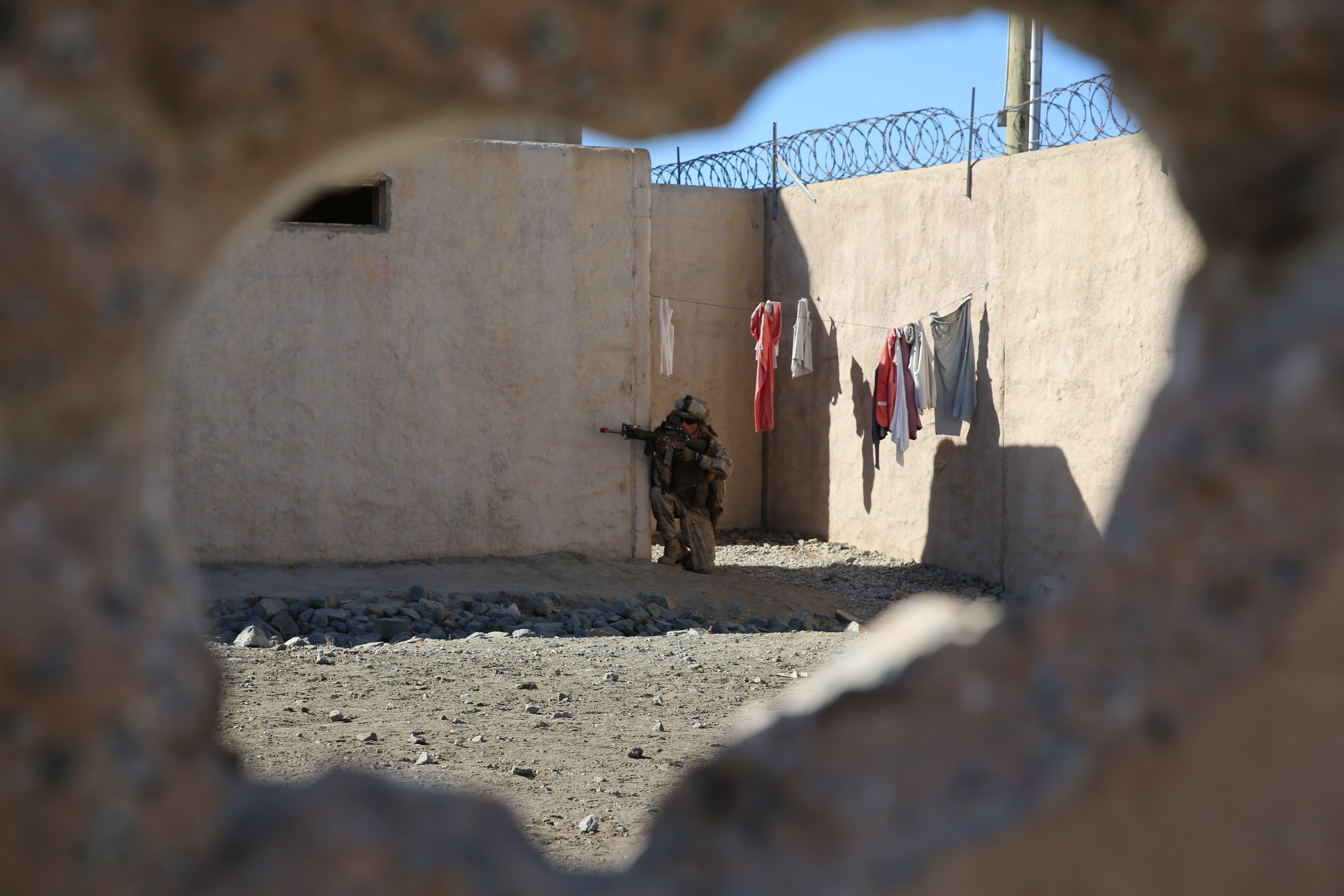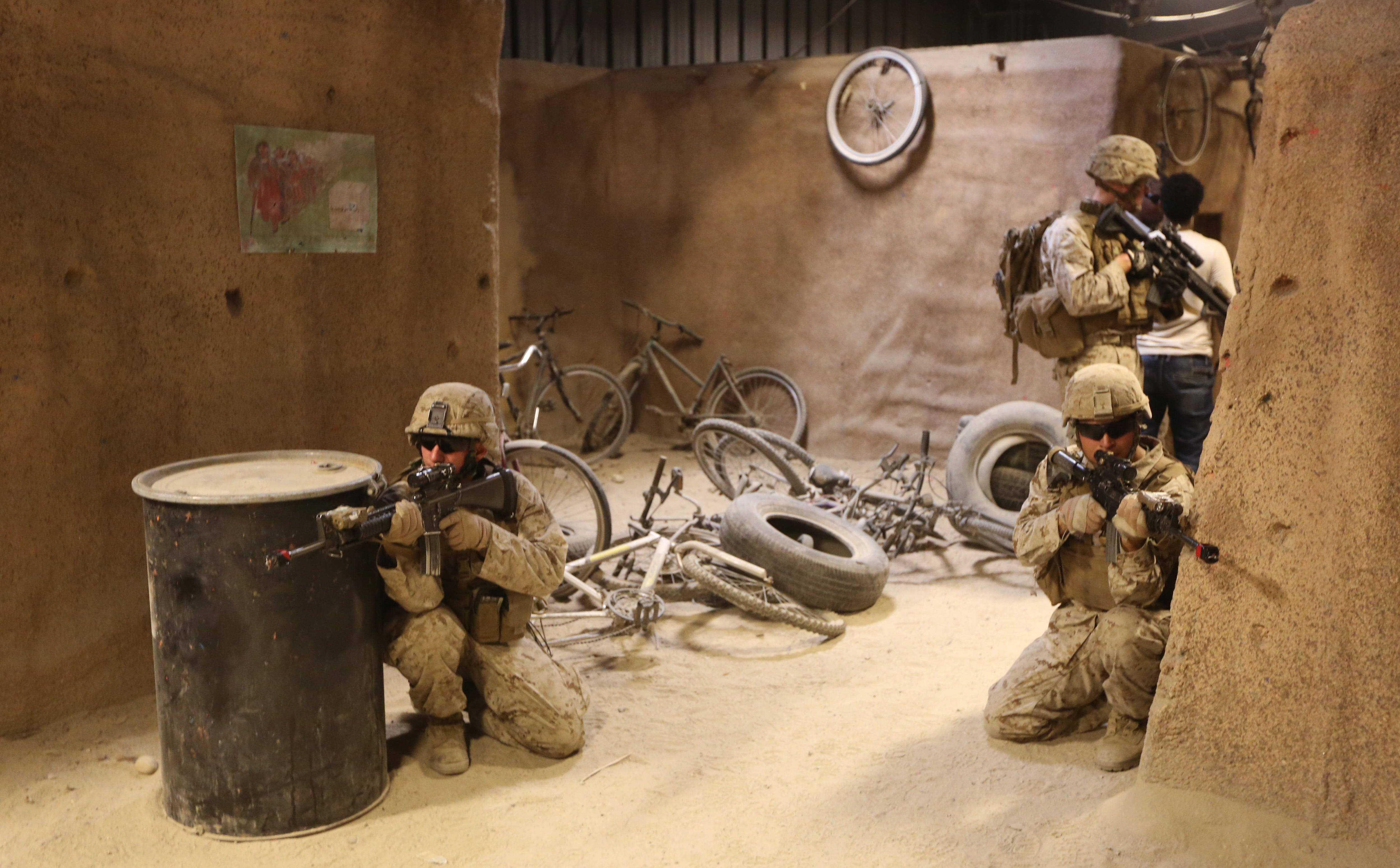Last year, Marines moving through one of the Corps' three infantry immersion trainers last year experienced the sights, sounds and smells of an Afghan town. Next year, the technology might be used to immerse troops in a Somali or Filipino village or a Filipino one -- and both worlds might be created back-to-back in the same trainer.
MOVED DOWN: The first infantry immersion trainer was a 2007 brainchild of then-Lt. Gen. James Mattis, who as commander of I Marine Expeditionary Force had an old tomato canning plant turned into an ultra-realistic training environment at Camp Pendleton. Since then, troops on the East and West Coasts and Hawaii have been able to train in squads amid a "fog of war" that simulates a deployed environment as realistically as possible, right down to the smells of sewers and cooking meat, the broadcast call to prayer, rocket-propelled grenade and improvised explosive device blasts, and village residents, played by role players.
Though Marines are largely out of Afghanistan, the immersion trainers are here to stay, said officials who manage the program for Training and Education Command. The environments and scenarios will get more diverse and the trainers themselves might become more adaptable, they said, but many of the components of that "fog of war" realism won't change at all.
The Corps' ongoing requirement for these high-realism training environments was reinforced in Commandant Gen. Joseph Dunford's planning guidance, released in January.
"We will particularly focus on better leveraging modern immersive training and simulation technologies," he wrote in the guidance. " … I expect all elements of the [Marine air-ground task force] to make extensive use of simulators where appropriate. My intent is for Marines to encounter their initial tactical and ethical dilemmas in a simulated battlefield vice actual combat."
The first infantry immersion trainer was a 2007 brainchild of then-Lt. Gen. James Mattis, who as commander of I Marine Expeditionary Force had an old tomato canning plant turned into an ultra-realistic training environment at Camp Pendleton. Since then, troops on the East and West Coasts and Hawaii have been able to train in squads amid a "fog of war" that realistically simulates a deployed environment as realistically as possible, right down to the smells of sewers and cooking meat, the broadcast call to prayer, rocket-propelled grenade and improvised explosive device blasts, and village residents, acted played by role players.

Marines with 1st Battalion, 4th Marines conduct urban operations training at the infantry immersion trainer aboard Camp Pendleton, Calif.
Photo Credit: Lance Cpl. Garrett White, I Marine Expeditionary Force
In a recent February interview with Marine Corps Times, Dunford said he expected the trainers and the scenarios to evolve involve in keeping to align training with wherever Marines might be headed and whatever they might be called to do.
"We read the intelligence every day, we take a look at potential scenarios, and we want to make sure that our training is informed by the most probable place we might be employed," he said.
Right now, the scenarios include embassy reinforcement and security and tactical recovery of aircraft and personnel (TRAP) missions, said Jack Cuddy, branch head for range and training area management at TECOM.
"Before we were focused on deploying unit requirements," he said. "Now we're getting more focused on [special purpose MAGTF] requirements."
The simulated environment will likely be different from trainer to trainer. In Hawaii, the only IIT location with ocean access for amphibious training, officials are completing a Pacific-oriented trainer makeover, replacing props, sounds and role players representing a village in Afghanistan with those depicting a southeast Asian setting. suited to an Afghan village with those appropriate to aAt Lejeune and Pendleton, the trainers are being remade with a "generic third-world" feel, Cuddy said.
The ambiguity is intentional.
"The danger of picking a place is, you've picked a place," said Nick Klaus, range requirements section head for TECOM. "So we want to remain as flexible as we can, try to pick the stuff that is wide-ranging, that will apply to the most possible efforts."

Marines with 2nd Battalion, 4th Marines provide security during a training exercise at Camp Pendleton, Calif. The infantry immersion trainer there helped them practice tactical skills and decision making ahead of a deployment.
Photo Credit: Lance Cpl. John Baker/Marine Corps
When it comes to building good decision-making under stress, Cuddy said, the chosen environment might not matter as much as the realism with which it is presented.
"In order to create the chaos and stress, all those types of things, what does a Marine need to be exposed to? Does he need to be exposed to somebody who speaks a particular language, or does he need to be exposed to someone who speaks a language different from his," Cuddy said. "Does it really matter if a guy's speaking Chinese, Korean, Somali, whatever … it doesn't really make a difference."
Cuddy and Klaus said the cost of changing a Middle Eastern village into an African or Pacific one is minimal, and covered by a recapitalization budget built into the range program. Purchase new signs and props, order different environmental sound and smell units and contract for role players from a different part of the world, and you're set, they said. As for the simulated chaos of the battlefield, from bomb blasts to RPG fire, well, those things tend to be the same in any conflict zone.
The trainer reset could become more costly, Cuddy said, if range officials are asked to move and reconfigure the concrete structures that make up the buildings within the trainers. But so far, no one has requested that, he said.
Where the Marine Corps may invest more heavily is in technology that will allow squads to review their run through the trainer more thoroughly and sooner after the action, Cuddy said. Range officials are exploring ways to get cameras and recording devices to capture more of what the Marines in the trainer do, from radio transmissions to movements during night raids. They're also looking at how ways to make the after-action review technology more portable, so that squads can conduct the review at their final location, or other units can adapt the immersion and review technology for use outside of the trainers. Recently, a motor transportation unit adapted a version of the immersion training for a convoy course, officials said.
Other items on the technology wish list may be years away. While officials in the past have touted the use of interactive avatar projections in the trainers to simulate village elders or other key characters, the limited range and one-dimensional quality of these avatars makes them clunky to use, Cuddy said.
"The technology is not there right now," he said. "The goal might be to replace all your role players with these guys. But the Star Trek holodeck is still a ways down the road."
Range officials also envision a future where they can create jungle and even arctic training environments in addition to the arid, desert-like environment that the current trainers provide. Models for those environments have been created, Klaus said, but they involve tremendous cost. Years down the road, virtual reality technology may also play a major part in the trainers, allowing Marines to experience people and scenes that aren't really there. But any system the Corps adopts will have to be good enough to all-but-convince Marines it's real.
"Anything we're doing, we're competing with XBox and a whole generation of Marines who grew up playing with that," Klaus said. "So that's the quality and level that they demand and anything short of that drops off real quick in its effectiveness in grabbing them. You're competing pretty tough when you're trying to create an artificial thing."




